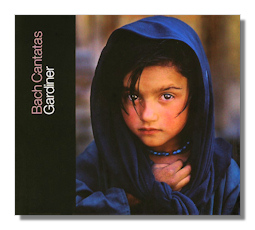
The Internet's Premier Classical Music Source
Related Links
-
J.S. Bach Reviews
Schütz Reviews - Latest Reviews
- More Reviews
-
By Composer
-
Collections
DVD & Blu-ray
Books
Concert Reviews
Articles/Interviews
Software
Audio
Search Amazon
Recommended Links
Site News
 CD Review
CD Review
Johann Sebastian Bach

Cantatas, Volume 2
Paris/Zürich
- Cantatas for the Second Sunday after Trinity 1
- Ach Gott, vom Himmel sieh darein, BWV 2
- Meine Seel erhebt den Herren, BWV 10
- Die Himmel erzählen die Ehre Gottes, BWV 76
- Cantatas for the Third Sunday after Trinity 2
- Ich hatte viel Bekümmernis, BWV 21
- Ach Herr, mich armen Sünder, BWV 135
- Concerto for Flute, Violin & Harpsichord, BWV 1044
- Heinrich Schütz: Die Himmel erzählen die Ehre Gottes, SWV 386 1
1 Lisa Larsson, soprano
1 Daniel Taylor, alto
1 James Gilchrist, tenor
1 Stephen Varcoe, bass
2 Katharine Fuge, soprano
2 Robin Tyson, alto
2 Vernon Kirk, tenor
2 Jonathan Brown, bass
The Monteverdi Choir
The English Baroque Soloists/John Eliot Gardiner
Soli Deo Gloria Records SDG165
Although marked as "Volume 2", this is actually the 24th in the projected series of not many more than that sets of CDs which John Eliot Gardiner made with soloists, The Monteverdi Choir and English Baroque Soloists throughout 2000. They are recordings of their worldwide Bach "pilgrimage" on which they performed the complete church cantatas of Bach on the liturgical feast days for which they were originally written. It's tempting to see such an apparent numbering anomaly as yet more evidence of the extreme care and meticulousness with which the project (originally in the hands of Deutsche Grammophon) was conceived, and has been executed… the final pieces of a holistically-planned jigsaw falling into place to the delight of everyone, regardless of how they have the beautifully-packaged CD sets shelved. But that's hardly necessary.
The interpretations and performances themselves do ample yet unobtrusive justice to Bach's amazing cycle. Every note, every phrase, vowel and consonant, almost, is lovingly articulated. That, of course, is exactly in keeping with Bach's purpose: to convey a devotional tenet or emotion in a way accessible to his congregations. Nor is James Gilchrist's rounded and penetrating tenor (one of the high points of the enterprise) which opens this set an isolated case. Nor either is the playing of the instrumentalists: the oboe and string obbligato in the Sinfonia in BWV 76 [CD.1 tr.22] is another pleasing example of outstanding technique and exactitude in the service of mature and informed expression. The relationships of tempi and dynamics with which the chorus "intervenes", comments and supplements the arias and recitatives – listen to its confidence at the end of BWV 2, Ach Gott, vom Himmel sieh darein [CD.1 tr.6], for example, – bespeak Gardiner's and his forces' lofty yet totally persuasive and at the same tine uncluttered and equally rich and deep understanding not only of the greatness of Bach's cantatas; but also of the impact they were designed to make. And written, rehearsed and performed to a grueling schedule during Bach's Leipzig years in particular.
In this sense, the real achievement of the cycle (which must now be considered the frontrunner of the three currently available) is the way in which each movement is brought to life in the context of the whole. There is vibrancy, enthusiasm and brightness of sound. Yet each in the service of a confessional purpose that was at times highly personal, despairing, rapturous, committed, appreciative and hopeful. The cantatas are almost weighed down with emotion; that emotion needs to be conveyed with sincere and barely detached expression. Not by a series of "devices". Gardiner here succeeds extraordinary well.
These five cantatas are for the Second and Third Sundays after Trinity; they were recorded in July 2000 – in the resonant Basilique Saint-Denis (Paris) in front of an audience and in the Fraumünster (Zürich) respectively. Also on the CD is Schütz' equally uplifting Die Himmel erzählen die Ehre Gottes for comparison with BWV 76 and because it was dedicated to the choir of St. Thomas, Leipzig, where Bach lived and worked, of course, for the last quarter century of his life. Indeed, BWV 76 was the second cantata to be performed after Bach became Thomaskantor. It makes a refreshing and instructive contrast. There's also the so-called Triple Concerto (for flute, violin and harpsichord), BWV 1044.
The CD quality is well up to SDG's established standard. The soloists are closely miked. That makes sense, though: the acoustics of the Thomaskirche in particular, and also of Weimar's Herderkirche are such that even gently sung lines are highly audible. Listen to Lisa Larsson's limpid yet forceful aria, "Hört, ihr Völker, Gottes Stimme" [CD.1 tr.17], for example. So an emphasis on such intimate communication is both historically authentic and artistically successful for us. The essays which Gardiner wrote are comprehensive, communicate more than what ought to be included in a performance diary, and give a useful background to the genesis and history of each work. As a package (fewer cantatas survive for the Second Sunday than is often the case for other occasions) and as accounts of each work as directed, exemplary and yet unspectacularly persuasive and idiomatic this CD can safely be recommended and should be bought without hesitation by anyone collecting the cycle, and – for that matter – by anyone as yet unfamiliar with this area of the repertoire and/or with this twenty-first century recording milestone. They'll be back. And so will we!
Copyright © 2010, Mark Sealey.





















